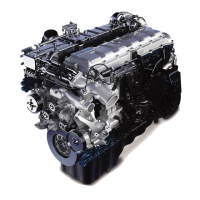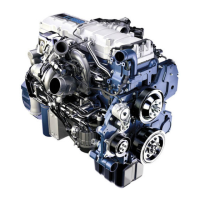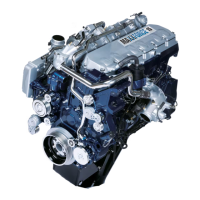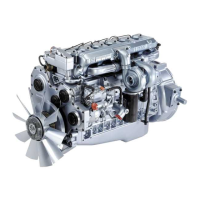7 ELECTRONIC CONTROL SYSTEMS DIAGNOSTICS 295
movement occurs when the crank lever in the control
module moves.
Exhaust gas flow can be regulated depending on
required exhaust back pressure for engine speed
and load. As demand for EBP increases, the ECM
increases the pulse-width modulation to the VGT
control module. When EBP demand decreases, the
ECM decreases the duty cycle to the control module.
Actuator control for the vane position is achieved by
setting a pulse width modulated signal from the ECM
in re sponse to the following:
• Engine sp eed
• Desired fuel quantity
• Boost
• Exhaust back pressure and altitude
The Exhaust Gas Recirculation (EGR) system
controls the amount of exhaust gas being introduced
to the e ngine mixer duct by modulating the EGR
valve. The EGR actuator is located at the front of the
engine on the mixer duct.
The EG R drive modu le controls the E GR actuat or and
is located on the left side of the engine on the ECM
and Injector Driver Module (IDM).
The ECM calculates the appropriate desired EGR
valve position in response to the changing engine
speed, fuel desired, operator demand, engine
operating temperatures, exhaust back pressure,
boost pressure and altitude. The ECM uses sensor
input from the follo win g :
• Variable Geometry Turbocharger (VGT) actuator
• Accelerator Position Sensor (APS)
• EGR actuator with position sensors
• EGR drive module
• Exhaust Back Pressure (EBP) sensor
• Manifold Absolute Temperature (MAT) sensor
• Barometric Absolute Pressure (BAP) sensor
• Engine Coolan t Temperature (ECT) sensor
• Engine Oil Temperature (EOT) sensor
• Manifold Absolute P ressure (MAP) sensor
The EGR drive module provides feedback to
the ECM on the valve position. The EGR d rive
module interprets the ECM command and sends the
comman d using three pulse width modulated signals
to the valve actuator.
The system is closed loop control using the EGR
position signals. The EGR drive module provides a 9
V supply and ground to the Integrated Circuit (IC) in
the motor of the valve. W hen the EGR drive module
directs the valve to move, the IC with thr ee Hall effect
sensors provides the EGR drive module with the valve
position signals. The EGR drive module interprets the
three signals to determine valve position and sends
the information back to the ECM.
Fault Detection / Management
The ECM continuously monitors the Air Management
System (AMS). When the ECM detects a fault in the
any of the interdependent systems, the ECM will set
a DTC and illuminate the am be r EN GINE lamp.
The Variable Geometry Turbocharger (VGT) is
continuously m onitored by the ECM using the exhaust
back pressure and the VGT pulse-width modulated
signal’s duty cycle. A DTC is logged when the ECM
determines that the duty cycle required to reach the
desired boost or exhaust back pressure is greater
or less than the ECM’s pre-programmed expec ted
values.
The Exhaust Gas Recirculation (EGR) actuator is
continuously monitored by the EGR drive module.
When an EGR control error is detected, the EGR
drive module sends a message to the ECM, a DTC is
set, and the amber ENGINE lamp is illuminated. For
additional function and operational information, see
“EGR Actuator” (page 413).
AMS Diagnostic Trouble Codes (DTCs)
DTCsarereadusingtheElectronicServiceTool(EST)
or by counting the flashes from the amber and re d
ENGINE lamp.
NOTE: Before proceeding make sure all sensor,
injector and act ua tor electrical DTC s have been
repaired. Follow the procedures outlined in Section 6
or Performance Diagnostics form.
EGES-270-1
Read all safety instructions in the "Safety Information" section of this manual before doing any procedures.
Follow all warnings, cautions, and notes.
© August 2008 Navistar, Inc.

